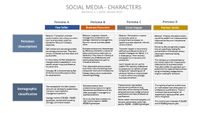Communication Patterns and User Characteristics on Business Platforms: The Case of XING
By Prof. Dr. Alfred-Joachim Hermanni
05.01.2016 / Revision 2022
Abstract
Social networks such as XING and LinkedIn are playing an increasingly important role in the professional context, particularly as communication, marketing and sales tools. Despite the availability of sociodemographic data, there is still little empirically sound knowledge about the typical behavioral patterns of users of such platforms in the context of social media events. This article presents the results of an empirical study conducted with 150 XING users by means of standardized interviews. Four prototypical user groups were identified: “Fast Sellers,” “Business Contactors,” “Event Hoppers,” and “Partner Surfers.” These characters differ in their motivations, communication styles, and networking skills and often have an tense relationship with each other. The study contributes to the typification of social media users in a business environment and provides starting points for further research.
1. Introduction
Business platforms such as XING and LinkedIn are becoming increasingly important for maintaining business contacts and as marketing and event organization tools. This raises the central question of which user groups engage on these platforms and how their communication behavior is structured. So far, the scientific debate has primarily focused on sociodemographic characteristics (see Neuberger & Langenohl, 2019; Wellbrock & König, 2022), while insights into specific usage habits, particularly in the context of live events, are lacking. This paper addresses this by identifying and classifying typical user types.
2. Theoretical background
Business networks can be described as hybrid platforms that enable both digital and analog interactions (Krotz & Hepp, 2018). While LinkedIn operates globally, XING focuses primarily on German-speaking countries. There are a variety of motivations for using the platform, ranging from professional to private interests. Research discusses networking (Ellison et al., 2007), self-presentation (Meier, 2020) and the constitution of social capital (Putnam, 2000) as central functions. However, a systematic typology of users of social business platforms is still lacking.
3. Methodology
3.1 Research design
In the period from January to August 2015, standardized interviews were conducted with 150 randomly selected platform users as part of several XING events. The aim was to identify recurring characteristics of social media users and to systematize them on the basis of typical behavior patterns.
3.2 Data collection
As moderator of a XING group with over 5,000 members, the author had direct access to potential interview partners. The questionnaire included sociodemographic data (age, gender, education, income) and, in particular, questions about usage behavior and motivation. The answers were dichotomous (yes/no). A pre-test was carried out before the main survey to ensure the validity and comprehensibility of the items.
4. Results
The analysis of the interviews allowed the respondents to be differentiated into four characteristic groups, which are outlined below (see also Figure 1).
It is noteworthy that many users switch between professional and private group affiliation, depending on the type of event. In addition, a tension dynamic between the groups emerged: for example, business networkers often reject fast salespeople as “dubious,” while event hoppers and partner surfers are avoided by business-oriented users.
One key finding concerns network competence: business networkers and fast salespeople are significantly more networked than the other groups, both on the platform itself and in the context of personal interactions.
(Source: Hermanni, A.-J.: 2015/Revision 2022)
5. Discussion
The study provides initial empirically based evidence that users of business platforms can be categorized into clearly distinguishable character types. This typology not only opens up perspectives for the further development of communication science theories on digital network formation, but also provides practical implications for the event and community management of business platforms.
It should be noted, however, that the study only examined XING users in German-speaking countries and that the results can only be applied to other platforms to a limited extent. Further research could be conducted to make cross-platform and international comparisons.
6. Conclusion
The present study has provided a first systematic approach to characterizing social media users on business platforms. The differentiation into four prototypical groups forms a basis for future research in the field of professional communication, network building and digital socialization. However, an empirical study of the research subject in the sense of a theoretically sound and systematic analysis could not be provided.
Based on this, the question of how many people can be assigned to the four groups was not relevant to this research process. Nevertheless, the result makes it clear which groups of people are substantially active in business networks. However, further research is needed to test the theoretical approaches and the method used. In this context, a sufficiently large, representative sample should also be taken.
Bibliography
• Ellison, N. B., Steinfield, C., & Lampe, C. (2007). The benefits of Facebook “friends”: Social capital and college students' use of online social network sites. Journal of Computer-Mediated Communication, 12(4), 1143–1168.
• Krotz, F., & Hepp, A. (2018). Mediatization: Case Studies in the Transformation of Communication. Springer VS.
• Meier, A. (2020). Digitale Selbstpräsentation in sozialen Netzwerken. In: Bentele, G., Piwinger, M. & Schönborn, G. (Eds.): Handbuch Public Relations. Springer Gabler.
• Neuberger, C., & Langenohl, A. (2019). Digitale Öffentlichkeit: Plattformen zwischen Privatheit und Öffentlichkeit. Medien & Kommunikationswissenschaft, 67(3), 302–321.
• Putnam, R. D. (2000). Bowling Alone: The Collapse and Revival of American Community. Simon & Schuster.
• Wellbrock, C., & König, M. (2022). The role of digital platforms in professional network formation. Publizistik, 67(2), 147–165.


.jpg/picture-200?_=18d4629d090)